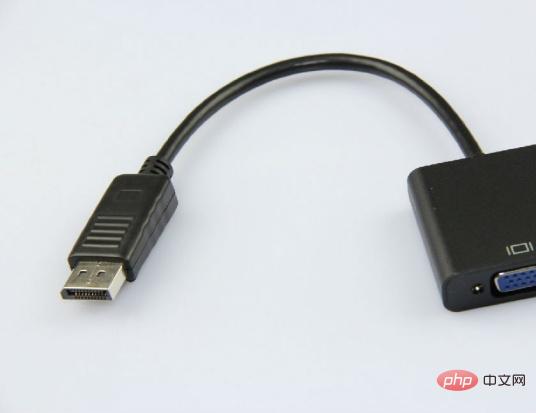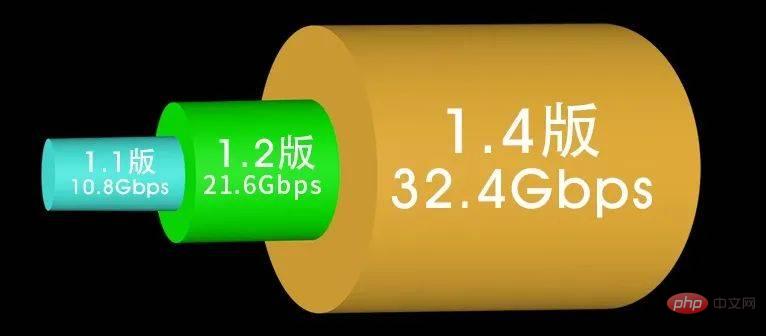What is the dp interface?
The dp interface is a display interface, a digital video interface standard developed by the PC and Chip Manufacturers Alliance and standardized by the Video Electronics Standards Association (VESA). The dp interface can connect a computer and a monitor, or a computer and a home theater. It is the first display communication port to rely on packetized data transmission technology.

The operating environment of this tutorial: Windows 7 system, Dell G3 computer.
The dp interface is a display interface.
dp stands for "DisplayPort". It is a digital video interface standard developed by the PC and Chip Manufacturers Alliance and standardized by the Video Electronics Standards Association (VESA). It can be connected to a computer and a monitor, or Computers and Home Theater. This interface is free of certification and license fees. It is mainly used to connect video sources to monitors and other devices, and also supports carrying audio, USB and other forms of data.
This interface is designed to replace the traditional VGA, DVI and FPD-Link (LVDS) interfaces. The interface is backwards compatible with legacy interfaces such as HDMI and DVI via active or passive adapters.

The dp interface is the first display communication port to rely on packetized data transmission technology, which can be used on Ethernet, USB, PCI Express, etc. Found in technology. It can be used for both internal and external display connections. Different from past standards that required fixed transmission of timer signals in the differential pair of each output end, the DisplayPort protocol is based on small data packets called micro-messages. This micro-message can embed the timer signal in in the data stream. The advantage is that with a smaller pin count, higher resolution can be achieved. Data messaging applications also allow DisplayPort to be extensible, meaning that additional functionality can be added over time without significant changes to the physical communications port itself.
The dp interface can be used to transmit audio and video simultaneously, each of which can be transmitted independently without the other. The video signal path can have 6 to 16 bits per color channel, and the audio path can have up to 8 channels of 24-bit 192 kHz uncompressed PCM audio, or a compressed audio format can be encapsulated in the audio stream. A bidirectional, half-duplex auxiliary channel carries device management and device control data for the primary link, such as VESAEDID, MCCS and DPMS standards. Additionally, the communication port is capable of carrying bidirectional USB signals.
DisplayPort signals are not compatible with DVI or HDMI. However, dual-mode DisplayPorts are designed to transmit single-link DVI or HDMI1.2/1.4 protocols through the communication port, which is accomplished by using an external passive connector to select the desired signal and convert the electrical signal from LVDS Convert to TMDS. Dual-mode DisplayPorts with passive connectors do not support VGA and dual-link DVI. These communication ports require active connectors to convert the protocols and signals required for output. VGA connectors can be powered using the DisplayPort connector, while dual-link DVI connectors may rely on external power (see HDMI, DVI, and VGA Compatibility).
DisplayPort connectors can have 1, 2, or 4 differential data pairs (lanes) on the main link, and each lane can run at 162, 270, or 540MHz on a self-timer basis. The rate is 1.62, 2.7 or 5.4 Gbit/s. The data is 8b/10b encoded, that is, each 8-bit message is encoded into a 10-bit symbol. Therefore, the effective data transfer rates per channel after decoding are 1.296, 2.16, and 4.32 Gbit/s (or 80% of the total).

# As the successor of DVI, the DP interface can also be simply understood as an enhanced version of HDMI. It transmits video signals while adding support for high-definition audio signal transmission, while supporting higher resolutions and refresh rates. For data transmission, DP uses a "micro-packetised" format and is highly scalable, allowing more new content to be added in the future.

DP version development
- ##1.1 Bandwidth 10.8Gbps, up to 2560*1600 (2K) resolution Rate (basically eliminated)
- 1.2 Bandwidth 21.6Gbps, up to 4K (4096*2160) 60Hz (most commonly used)
- 1.3 Bandwidth 32.4Gbps, supporting up to 4K (3840X2160) 120hz, 5K (5120X2880) 60hz, 8K (7680X4320) 30hz output.
- 1.4 Bandwidth 32.4Gbps, supports up to 8K level (7680x4320) 60Hz output, and 4K can go up to 120Hz. (Latest version)
- 2.0 has a bandwidth of up to 80Gbps, which is 2.5 times that of the current DP1.4 and 1.6 times that of HDMI 2.1. It can output 16K 60Hz (DSC) and 10K 60Hz lossless on a single screen. , 4K 240Hz and other images, supporting dual-screen 4K 144Hz lossless.
How to choose DP line
When we buy DP cables, we will find that there are many types of DP cables. According to size, they are divided into DP interfaces and mini DP interfaces developed by Apple. They are divided into male-to-male and male-to-female.
The most common one is DP male-to-male HD cable, which is generally used as a direct connection cable for device interconnection. It is also called a video cable. For example, the computer output terminal is connected to the TV input terminal; male-to-female cable is generally used for data extension. Line or special equipment connection line, so it is also called conversion line.
In fact, it is not difficult to choose the correct DP cable. Just confirm the DP cable standard according to your own equipment configuration and your own requirements for game and video output effects. If you want to experience 8K ultra-clear vision and smooth game operation, we recommend version 1.4 DP HD cable.
Notes on using DP adapter/conversion cable:
When only one end of the input device and output device you want to connect is a DP interface, then use the adapter Please pay attention when connecting the adapter/conversion cable:
DP to HDMI can achieve two-way transfer, and the transmission picture will not be distorted;
DP to DVI is a one-way transfer, DP to DVI products can only convert DP to DVI. The DP terminal is connected to the computer host graphics card, and the DVI is connected to the monitor. If used vice versa, there will be no display;
DP to VGA, these two interfaces cannot be directly connected, and an adapter is required Add a chip, but generally the adapters sold have chips added, so you generally don’t have to worry about this problem.
For more related knowledge, please visit the FAQ column!
The above is the detailed content of What is the dp interface?. For more information, please follow other related articles on the PHP Chinese website!

Hot AI Tools

Undresser.AI Undress
AI-powered app for creating realistic nude photos

AI Clothes Remover
Online AI tool for removing clothes from photos.

Undress AI Tool
Undress images for free

Clothoff.io
AI clothes remover

Video Face Swap
Swap faces in any video effortlessly with our completely free AI face swap tool!

Hot Article

Hot Tools

Notepad++7.3.1
Easy-to-use and free code editor

SublimeText3 Chinese version
Chinese version, very easy to use

Zend Studio 13.0.1
Powerful PHP integrated development environment

Dreamweaver CS6
Visual web development tools

SublimeText3 Mac version
God-level code editing software (SublimeText3)

Hot Topics
 1386
1386
 52
52
 How to tell whether the dp interface is 1.2 or 1.4?
Feb 06, 2024 am 10:27 AM
How to tell whether the dp interface is 1.2 or 1.4?
Feb 06, 2024 am 10:27 AM
The DP interface is an important interface cable in the computer. When using the computer, many users want to know how to check whether the DP interface is 1.2 or 1.4. In fact, they only need to check it in GPU-Z. How to determine whether the dp interface is 1.2 or 1.4: 1. First, select "Advanced" in GPU-Z. 2. Look at "Monitor1" in "General" under "Advanced", you can see the two items "LinkRate (current)" and "Lanes (current)". 3. Finally, if 8.1Gbps×4 is displayed, it means DP1.3 version or above, usually DP1.4. If it is 5.4Gbps×4, then
 What does the dp interface look like?
Mar 16, 2023 pm 02:06 PM
What does the dp interface look like?
Mar 16, 2023 pm 02:06 PM
The DP interface is a digital video interface developed by the PC and Chip Manufacturers Alliance and standardized by VESA (Video Electronics Standards Association). The DP interface does not require certification or payment of authorization fees. It is mainly used to connect devices such as video sources and displays. It also supports the transmission of audio, USB and other data. There are two types of DP interfaces: standard DP interface and Mini DP interface. However, because the shapes of the interfaces are different, the two cannot be used universally. Only by using the corresponding DP cable can the correct connection to the display device be achieved.
 What is the dp interface?
Mar 10, 2023 pm 05:53 PM
What is the dp interface?
Mar 10, 2023 pm 05:53 PM
The dp interface is a display interface, a digital video interface standard developed by the PC and Chip Manufacturers Alliance and standardized by the Video Electronics Standards Association (VESA). The dp interface can connect a computer and a monitor, or a computer and a home theater. It is the first display communication port to rely on packetized data transmission technology.
 Does 144hz require dp interface?
Mar 16, 2023 pm 01:44 PM
Does 144hz require dp interface?
Mar 16, 2023 pm 01:44 PM
It is not necessary to use dp cable for 144hz. "DP cable" is a data cable that supports the DP interface, and the DP interface is only one of the 144hz interfaces. The 144hz effect can also be achieved through the HDMI2.0 interface. However, if the display needs to reach 144hz, then the display itself needs to reach 144hz, otherwise it will still not be possible.
 How to unplug the dp interface
Feb 06, 2024 pm 06:42 PM
How to unplug the dp interface
Feb 06, 2024 pm 06:42 PM
The DP interface is an interface used in computers. When many users want to pull it out, they find it difficult to pull it out. They want to know how to pull it out. Just pay attention to the barbs on the DP interface when pulling it out, and you can pull it out. Came down. How to remove the DP interface: 1. First, you need to use a clip to clamp the button on the DP interface and let the anti-removal barb retract. 2. If the anti-detachment barb is not retracted and the interface is pulled out with brute force, the interface will be damaged. 3. Finally, press and hold the button, shrink the barb, and it can be pulled out smoothly.
 How to connect the monitor to the dp interface
Feb 06, 2024 pm 03:40 PM
How to connect the monitor to the dp interface
Feb 06, 2024 pm 03:40 PM
When many users are DIYing their own computers, they don't know how to use the DP interface to connect to the monitor. The method is actually very simple. Just connect the interface to the computer's host first, and then plug the other end into the monitor. How to connect the DP interface to the monitor: 1. First take out the DP interface cable. 2. Then connect a section of interface cable to the back of the host. 3. Finally, plug the other end into the monitor and it is successfully connected to the monitor.
 How to connect DP interface to hdmi
Feb 07, 2024 pm 05:57 PM
How to connect DP interface to hdmi
Feb 07, 2024 pm 05:57 PM
Many users find when using computers that the host computer has a DP interface, but the display interface is HDMI and cannot be connected. They want to know if there is any way to connect the two. They only need a converter to connect them. . How to connect the DP interface to HDMI: 1. First, you need to prepare a DP interface to HDMI converter. 2. Then use the DP interface to connect to the graphics card. 3. Finally, connect it to the HDMI cable of the monitor.
 How to output switch on dp interface
Feb 07, 2024 pm 12:00 PM
How to output switch on dp interface
Feb 07, 2024 pm 12:00 PM
Many users want to use the DP interface to connect to the Switch host, but they don’t know how to connect and can’t find a way. It’s actually very simple. Just use a cable with an HDMI interface on one side and a DP interface on the other side. . How to output switch from DP interface: 1. First, you need a connecting cable with HDMI interface on one side and DP interface on the other side. 2. Then find several interfaces on the monitor. 3. Finally, use the HDMI interface to connect to the SWITCH host base.



